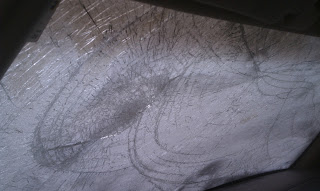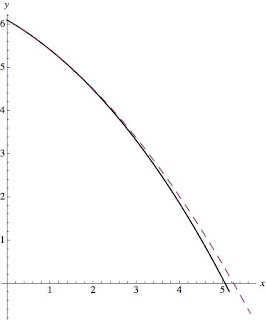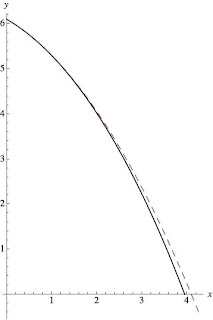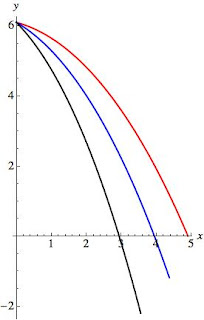Falling Ice
 It's been a while since I posted anything, much to my shame. Hopefully
this post marks a change in that streak. Today I'm going to consider a
very practical application of all this physics stuff. One of my
housemates parks his car on the side of the house, with the front of the
car facing the house. Living in Ithaca, NY, the weather has been the
usual cold and snowy, like the rest of the northeast USA this winter.
Yet, early last week, we had some unusually warm weather, in the 30s
(fahrenheit). A few days later, my housemate went out to his car, and
discovered that falling chunks of ice had broken his windshield! Now, to
be clear here, I'm not talking about icicles, I'm talking about large,
block-like, chunks. My best guess is that during the warm days, snow on
the roof turned into chunks of ice, and slid off the roof. The question
I'm going to try to answer today is: How far from the house could these
chunks possibly land? Put another way, what I want to know is, how far
from the house would we have to park our cars to not risk broken
windshields from falling ice? The First Attempt We'll start with the
simplest assumptions we can think of. First, we'll assume that there is
no friction on the ice block as it slides down the roof. We'll also
assume there's no air resistance slowing down the ice in the air. The
maximum range will be given by a block of ice sliding from the top of
the roof. Taking the height of the peak of the roof as h, relative to
the edge of the roof, we can write down the magnitude of the velocity of
the ice chunk when it reaches the edge of the roof. We start by setting
the change in gravitational potential energy equal to the change in
kinetic energy. Recalling the form for both of these, $$PE=mgh$$
$$KE=\tfrac{1}{2}mv^2$$ we can set these equal and solve for v, $$mgh
= \tfrac{1}{2}mv^2$$ so $$|v|=\sqrt{2gh}$$ This should be a familiar
expression to anyone who went through introductory mechanics. Now, given
that the roof is at an angle theta, we can write down the x (horizontal)
and y (vertical) components of velocity, $$v_x=|v|\cos\theta$$
$$v_y=-|v|\sin \theta$$ where I've introduced a minus sign in the y
component of velocity to indicate that the ice chunk is falling. Now
that we have the velocity, we have to call upon some more kinematics. To
figure out how far the ice flies, we have to know how long it is in the
air. So we start by considering the vertical motion. The distance
traveled by an object with an initial velocity, v_0, and a constant
acceleration, a, is given by $$\Delta y=\tfrac{1}{2}at^2+v_0t$$ In
our case, the distance traveled is the height of the first two floors of
my house. The acceleration is that of gravity, g, and the initial
velocity is the y component of velocity we found above. We'd like to
find the time it takes to travel this distance. We have to be a little
careful with our minus signs, by our convention the acceleration is in
the negative direction, and the change in position is negative. Working
all of that out, and plugging in our known values, we get
$$\tfrac{1}{2}gt^2+|v|\sin \theta t - l =0$$ where l is the height
of the house. We can solve this for t, finding $$t=\frac{-|v|\sin
\theta + \sqrt{(|v|\sin \theta)^2+2gl}}{g}$$ The horizontal
distance traveled is simply the horizontal velocity times the time,
$$x=\frac{|v|\cos\theta}{g}(-|v|\sin \theta + \sqrt{(|v|\sin
\theta)^2+2gl})$$ a result that you may recognize as the 'projectile
range formula' (particularly if I brought the minus on the v sine theta
term into the sine, indicating that I'm firing at a negative angle, that
is, downwards). Having found that result, lets plug in our velocity, and
then some numbers. First,
$$x=\frac{\sqrt{2gh}\cos\theta}{g}(\sqrt{2gh}\sin \theta +
\sqrt{(2gh\sin^2 \theta+2gl})$$ Now, for some estimation. I'd say
that the height of the roof peak is 10 ft, the height of the first two
floors of the house is 20 ft, and the angle of the roof is 30 degrees.
Having made those estimates, now I just have to plug in all the numbers,
yielding $$x=5.2 m=17 ft$$ That's a very long range! Now, I didn't see
any chunks of ice that were more than about 7 ft from the house. So we
have to question what went wrong with the above derivation. Well, maybe
nothing went wrong. I did calculate the maximum range. It's quite
possible none of these ice chunks were from the very top of the roof.
Still, I'm inclined to think we may have overestimated. I'd say that our
initial velocity was too high. The ice, as it comes down the roof, will
have to push a bunch of snow out of the way. Even though it may not have
much friction with the roof, all that snow will slow it down, and reduce
the velocity with which it comes off. I'm just going to guess that about
half of the potential energy it had is lost to the snow and roof, as a
rough estimation. That would give a velocity $$|v| = \sqrt{gh}$$ and a
maximum distance of $$x= 4m = 13ft$$ which is closer to what I observed.
The Second Attempt I'm still not completely satisfied with the
previous work, the answer doesn't match my observation. As a wise man
(Einstein) once said, "make things as simple as possible, but no
simpler." I may be guilty of making the problem too simple here. So I'm
going to add back in air resistance. In general, we physicists like to
avoid this because it usually means we can't get nice, analytic
expressions as answers (like the one I have above). Instead, we usually
just have to calculate the result numerically. This isn't the end of the
world, and often times it is actually a bit easier, but it's not as
pretty looking. Still, to satisfy myself, and you, gentle reader, I will
step into that realm. We start by writing down the force on our block of
ice once it is falling. We've got gravity, and air resistance. Thus
$$\vec{F}=-mg\hat{y}-bv^2\hat{v}$$ I've input a drag force that goes
as v^2, and is in the opposite direction of v. The 'v direction' is a
cop out, because I didn't want to do the explicit direction, so lets fix
that. We'll have x and y components, and we note that the magnitude of v
times the direction of v is the velocity vector. So,
$$\vec{F}=-mg\hat{y}-bv\hat{v}_x-bv\hat{v}_y$$ Breaking this up
into components we get $$a_x=-\frac{bv}{m}v_x$$
$$a_y=-g-\frac{bv}{m}v_y$$ This is as far as we can take this work
analytically. I'll say a little more about the coefficient b. This
depends on the exact size and shape of the object, as well as the medium
it is moving through. I'm going to use $$b=.4\rho A$$ because that's
what we used for hay bales in my classical mechanics class years ago.
Here, rho is the density of air, and A is the surface area of the
object. I would estimate that the large face of the ice chunk is roughly
one square foot, or .1 m^2. I'd estimate the mass of the ice was around
2 kg. Now, for some magic. I've put all of this into mathematica, and
asked it to solve this numerically. First we have the plot for the full
initial velocity, $$v=\sqrt{2gh}$$
It's been a while since I posted anything, much to my shame. Hopefully
this post marks a change in that streak. Today I'm going to consider a
very practical application of all this physics stuff. One of my
housemates parks his car on the side of the house, with the front of the
car facing the house. Living in Ithaca, NY, the weather has been the
usual cold and snowy, like the rest of the northeast USA this winter.
Yet, early last week, we had some unusually warm weather, in the 30s
(fahrenheit). A few days later, my housemate went out to his car, and
discovered that falling chunks of ice had broken his windshield! Now, to
be clear here, I'm not talking about icicles, I'm talking about large,
block-like, chunks. My best guess is that during the warm days, snow on
the roof turned into chunks of ice, and slid off the roof. The question
I'm going to try to answer today is: How far from the house could these
chunks possibly land? Put another way, what I want to know is, how far
from the house would we have to park our cars to not risk broken
windshields from falling ice? The First Attempt We'll start with the
simplest assumptions we can think of. First, we'll assume that there is
no friction on the ice block as it slides down the roof. We'll also
assume there's no air resistance slowing down the ice in the air. The
maximum range will be given by a block of ice sliding from the top of
the roof. Taking the height of the peak of the roof as h, relative to
the edge of the roof, we can write down the magnitude of the velocity of
the ice chunk when it reaches the edge of the roof. We start by setting
the change in gravitational potential energy equal to the change in
kinetic energy. Recalling the form for both of these, $$PE=mgh$$
$$KE=\tfrac{1}{2}mv^2$$ we can set these equal and solve for v, $$mgh
= \tfrac{1}{2}mv^2$$ so $$|v|=\sqrt{2gh}$$ This should be a familiar
expression to anyone who went through introductory mechanics. Now, given
that the roof is at an angle theta, we can write down the x (horizontal)
and y (vertical) components of velocity, $$v_x=|v|\cos\theta$$
$$v_y=-|v|\sin \theta$$ where I've introduced a minus sign in the y
component of velocity to indicate that the ice chunk is falling. Now
that we have the velocity, we have to call upon some more kinematics. To
figure out how far the ice flies, we have to know how long it is in the
air. So we start by considering the vertical motion. The distance
traveled by an object with an initial velocity, v_0, and a constant
acceleration, a, is given by $$\Delta y=\tfrac{1}{2}at^2+v_0t$$ In
our case, the distance traveled is the height of the first two floors of
my house. The acceleration is that of gravity, g, and the initial
velocity is the y component of velocity we found above. We'd like to
find the time it takes to travel this distance. We have to be a little
careful with our minus signs, by our convention the acceleration is in
the negative direction, and the change in position is negative. Working
all of that out, and plugging in our known values, we get
$$\tfrac{1}{2}gt^2+|v|\sin \theta t - l =0$$ where l is the height
of the house. We can solve this for t, finding $$t=\frac{-|v|\sin
\theta + \sqrt{(|v|\sin \theta)^2+2gl}}{g}$$ The horizontal
distance traveled is simply the horizontal velocity times the time,
$$x=\frac{|v|\cos\theta}{g}(-|v|\sin \theta + \sqrt{(|v|\sin
\theta)^2+2gl})$$ a result that you may recognize as the 'projectile
range formula' (particularly if I brought the minus on the v sine theta
term into the sine, indicating that I'm firing at a negative angle, that
is, downwards). Having found that result, lets plug in our velocity, and
then some numbers. First,
$$x=\frac{\sqrt{2gh}\cos\theta}{g}(\sqrt{2gh}\sin \theta +
\sqrt{(2gh\sin^2 \theta+2gl})$$ Now, for some estimation. I'd say
that the height of the roof peak is 10 ft, the height of the first two
floors of the house is 20 ft, and the angle of the roof is 30 degrees.
Having made those estimates, now I just have to plug in all the numbers,
yielding $$x=5.2 m=17 ft$$ That's a very long range! Now, I didn't see
any chunks of ice that were more than about 7 ft from the house. So we
have to question what went wrong with the above derivation. Well, maybe
nothing went wrong. I did calculate the maximum range. It's quite
possible none of these ice chunks were from the very top of the roof.
Still, I'm inclined to think we may have overestimated. I'd say that our
initial velocity was too high. The ice, as it comes down the roof, will
have to push a bunch of snow out of the way. Even though it may not have
much friction with the roof, all that snow will slow it down, and reduce
the velocity with which it comes off. I'm just going to guess that about
half of the potential energy it had is lost to the snow and roof, as a
rough estimation. That would give a velocity $$|v| = \sqrt{gh}$$ and a
maximum distance of $$x= 4m = 13ft$$ which is closer to what I observed.
The Second Attempt I'm still not completely satisfied with the
previous work, the answer doesn't match my observation. As a wise man
(Einstein) once said, "make things as simple as possible, but no
simpler." I may be guilty of making the problem too simple here. So I'm
going to add back in air resistance. In general, we physicists like to
avoid this because it usually means we can't get nice, analytic
expressions as answers (like the one I have above). Instead, we usually
just have to calculate the result numerically. This isn't the end of the
world, and often times it is actually a bit easier, but it's not as
pretty looking. Still, to satisfy myself, and you, gentle reader, I will
step into that realm. We start by writing down the force on our block of
ice once it is falling. We've got gravity, and air resistance. Thus
$$\vec{F}=-mg\hat{y}-bv^2\hat{v}$$ I've input a drag force that goes
as v^2, and is in the opposite direction of v. The 'v direction' is a
cop out, because I didn't want to do the explicit direction, so lets fix
that. We'll have x and y components, and we note that the magnitude of v
times the direction of v is the velocity vector. So,
$$\vec{F}=-mg\hat{y}-bv\hat{v}_x-bv\hat{v}_y$$ Breaking this up
into components we get $$a_x=-\frac{bv}{m}v_x$$
$$a_y=-g-\frac{bv}{m}v_y$$ This is as far as we can take this work
analytically. I'll say a little more about the coefficient b. This
depends on the exact size and shape of the object, as well as the medium
it is moving through. I'm going to use $$b=.4\rho A$$ because that's
what we used for hay bales in my classical mechanics class years ago.
Here, rho is the density of air, and A is the surface area of the
object. I would estimate that the large face of the ice chunk is roughly
one square foot, or .1 m^2. I'd estimate the mass of the ice was around
2 kg. Now, for some magic. I've put all of this into mathematica, and
asked it to solve this numerically. First we have the plot for the full
initial velocity, $$v=\sqrt{2gh}$$
 The solid line is with air resistance, the dashed line without air resistance. The plot shows vertical vs. horizontal distance, and the units are meters. (click to enlarge)
The solid line is with air resistance, the dashed line without air resistance. The plot shows vertical vs. horizontal distance, and the units are meters. (click to enlarge)
Next we have the plot for the half initial velocity, $$v=\sqrt{gh}$$
 The solid line is with air resistance, the dashed line without air resistance. The plot shows vertical vs. horizontal distance, and the units are meters. (click to enlarge)
The solid line is with air resistance, the dashed line without air resistance. The plot shows vertical vs. horizontal distance, and the units are meters. (click to enlarge)
As you can see from the plots, in neither case does it make a large difference, about .2 m. The Third Round The final thought that occurs to me is that perhaps I got the angle of the roof wrong. That would be quite easy. Humans are notoriously bad at estimating angles. I'll plot the results (with air resistance) for 15, 30, and 45 degree angles and the lower velocity.
 The plot shows vertical vs. horizontal distance, and the units are meters. The red line is 15 degrees, the blue line is 30 degrees, and the black line is 45 degrees. (click to enlarge)
The plot shows vertical vs. horizontal distance, and the units are meters. The red line is 15 degrees, the blue line is 30 degrees, and the black line is 45 degrees. (click to enlarge)
In summary, the answer is unclear. What I really need to do is measure the angle of my roof better, because there's a significant angle dependence. It's also quite possible that we didn't see a maximum distance hit (thankfully!). In addition, air resistance doesn't seem to matter much in this particular problem, probably because the distance the thing falls is short enough that terminal velocity is not reached. Hopefully this gave you a bit of a taste of a more practical physics problem, and how to approach air resistance (if you want to see the mathematica code, let me know). The lesson here seems to be either don't park too close to roofs, or have insurance for your windshield!
Comments
Comments powered by Disqus